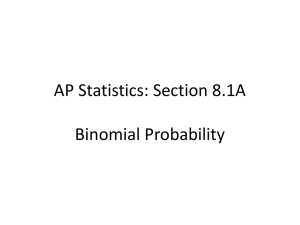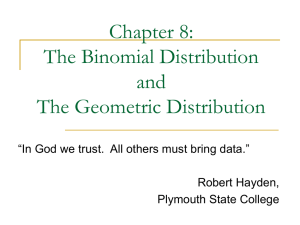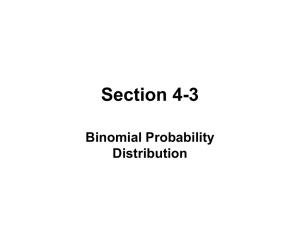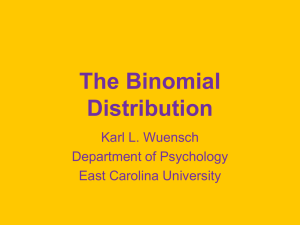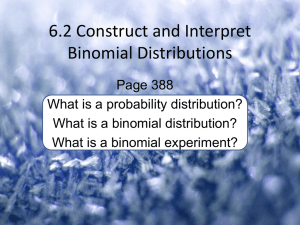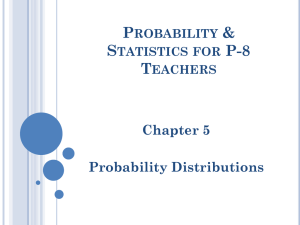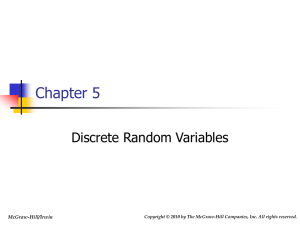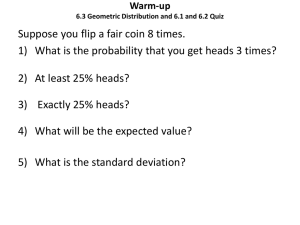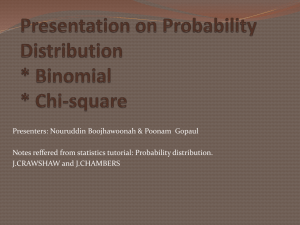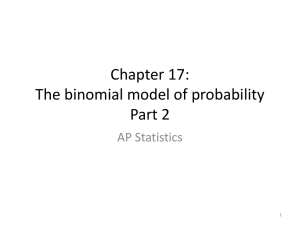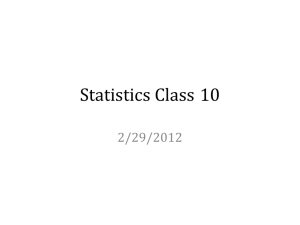Sec. 8.1 Part 2 PowerPoint
advertisement
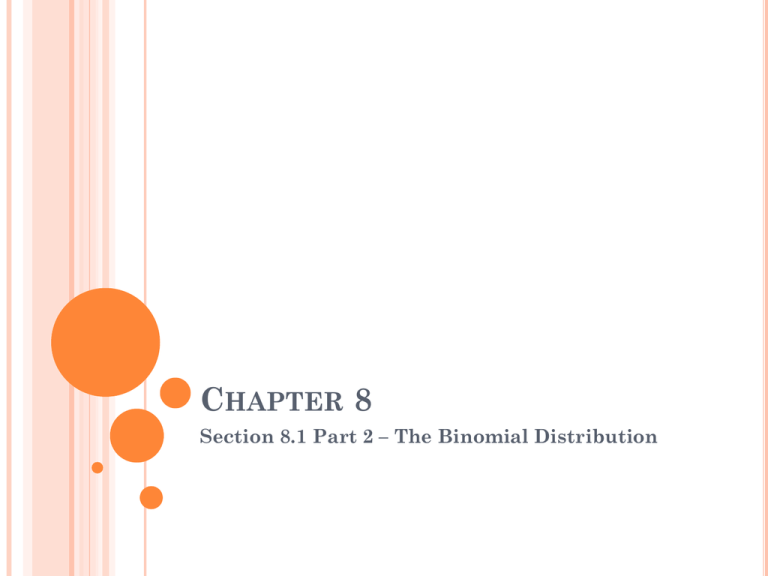
CHAPTER 8 Section 8.1 Part 2 – The Binomial Distribution UNDERSTANDING THE BINOMIAL FORMULA To best understand the formula for a binomial distribution, lets use the example of inheriting blood type with the B(5, .25) distribution. Each child of a particular pair of parents has probability 0.25 of having type O blood. Genetics says that children receive genes from each of their parents independently. If these parents have 5 children, the count X of children with type O blood is a binomial random variable with n = 5 trials and probability p = 0.25 of a success on each trial. In this setting, a child with type O blood is a “success” (S) and a child with another blood type is a “failure” (F). What’s P(X = 2)? P(SSFFF) = (0.25)(0.25)(0.75)(0.75)(0.75) = (0.25)2(0.75)3 = 0.02637 However, there are a number of different arrangements in which 2 out of the 5 children have type O blood: SSFFF SSFFF SFSFF SFSFF SFFSF SFFSF SFFFS FSSFF FSSFF SFFFS FSFSF FSFSF FSFFS FSFFS FFSSF FFSSF FFSFS FFFSS FFFSS FFSFS Verify that in each arrangement, P(X = 2) = (0.25)2(0.75)3 = 0.02637 Therefore, P(X = 2) = 10(0.25)2(0.75)3 = 0.2637 BINOMIAL COEFFICIENT Note, in the previous example, any one arrangement of 2 S’s and 3 F’s had the same probability. This is true because no matter what arrangement, we’d multiply together 0.25 twice and 0.75 three times. We can generalize this for any setting in which we are interested in k successes in n trials. That is, This is a combination… “n choose k” or nCr in your calculator P(X k) P(exactlyk successes in n trials) = number of arrangements pk (1 p) nk Definition: The number of ways of arranging k successes among n observations is given by the binomial coefficient n n! k k!(n k)! for k = 0, 1, 2, …, n where n! = n(n – 1)(n – 2)•…•(3)(2)(1) and 0! = 1. BINOMIAL PROBABILITY The binomial coefficient counts the number of different ways in which k successes can be arranged among n trials. The binomial probability P(X = k) is this count multiplied by the probability of any one specific arrangement of the k successes. Binomial Probability If X has the binomial distribution with n trials and probability p of success on each trial, the possible values of X are 0, 1, 2, …, n. If k is any one of these values, n k P(X k) p (1 p) nk k Number of arrangements of k successes Probability of k successes Probability of n-k failures EXAMPLE 8.10 – DEFECTIVE SWITCHES The number X of switches that fail inspection in example 8.3 has approximately the binomial distribution with n = 10 and p = .1. Using the binomial probability formula, determine the probability that no more than 1 switch fails. 𝑃 𝑋 ≤1 = 𝑃 𝑋 = 1 +𝑃 𝑋 =0 10 10 (.1)1 (.9)9 + (.1)0 (.9)10 1 0 10! 10! .1 .3874 + 1 . 3487) 1! 9! 0! 10! 10 .1 .3874 + 1 1 .3487 . 7361 Would need to write this on the AP exam BINOMIAL MEAN AND STANDARD DEVIATION Mean and Standard Deviation of a Binomial Random Variable If a count X has the binomial distribution with number of trials n and probability of success p, the mean and standard deviation of X are X np X np(1 p) Note- theseshort formulas are only good for binomial distributions EXAMPLE 8.11 – BAD SWITCHES Continuing example 8.10, the count X of bad switches is binomial with n = 10 and p = .1. This is the sampling distribution the engineer would see if she drew all possible SRSs of 10 switches from the shipment and recorded the value of X for each sample. What is the mean and standard deviation for this binomial distribution? 𝜇 = 𝑛𝑝 = (10)(.1) = 1 𝜎= 𝑛𝑝(1 − 𝑝) = 10 (.1)(1 − .1) = .9 = .9487 THE NORMAL APPROXIMATION TO BINOMIAL DISTRIBUTIONS As the number of trials, n, increases, the formula for finding binomial probabilities becomes impractical. Another alternative besides using a calculator is to use the normal distribution properties. We can do this because as the number of trials, n, gets larger, the binomial distribution gets close to a normal distribution. Normal Approximation for Binomial Distributions Suppose that X has the binomial distribution with n trials and success probability p. When n is large, the distribution of X is approximately Normal with mean and standard deviation X np(1 p) X np As a rule of thumb, we will use the Normal approximation when n is so large that np ≥ 10 and n(1 – p) ≥ 10. That is, the expected number of successes and failures are both at least 10. Be sure to check this before using the normal approx. for binomial distributions!! Recall, the sampling distribution of a count variable is only well-described by the binomial distribution is cases where the population size is significantly larger than the sample size. As a general rule, the binomial distribution should not be applied to observations from a simple random sample (SRS) unless the population size is at least 10 times larger than the sample size (or otherwise thought of as the sample size being no more than 10% of the population) 1 𝑁 ≥ 10𝑛 or 𝑛 ≤ 10 𝑁 EXAMPLE 8.12 – ATTITUDES TOWARDS SHOPPING Sample surveys show that fewer people enjoy shopping than in the past. A survey asked a nationwide random sample of 2500 adults if they agreed or disagreed that “I like buying new clothes, but shopping is often frustrating and time-consuming.” Suppose that exactly 60% of all adult US residents would say “Agree” if asked the same question. Let X = the number in the sample who agree. Without using the calculator function, estimate the probability that 1520 or more of the sample agree. Step 1: Verify that X is approximately a binomial random variable. B (binary?): Success = agree, Failure = don’t agree I (independent?): Because the population of U.S. adults is greater than 25,000 (10x2500) it is reasonable to assume the sampling without replacement condition is met. N (number?): n = 2500 trials of the chance process S (success?): The probability of selecting an adult who agrees is p = 0.60 EXAMPLE 8.12 – ATTITUDES TOWARDS SHOPPING Step 2: Check the conditions for using a Normal approximation Since np = 2500(0.60) = 1500 and n(1 – p) = 2500(0.40) = 1000 are both at least 10, we may use the Normal approximation. Step 3: Calculate P(X ≥ 1520) using a Normal approximation. np 2500(0.60) 1500 np(1 p) 2500(0.60)(0.40) 24.49 15201500 z 0.82 24.49 P(X 1520) P(Z 0.82) 10.7939 0.2061 If you check using your calculator, 𝑃 𝑋 ≥ 1520 = .2131, which is not far from .2060 (off by .007) BINOMIAL DISTRIBUTION WITH THE CALCULATOR Go through steps 1, 2, & 6 on p.456-457 to learn how to enter probability distributions in your calculator lists. Part 2 HW: p.449-462 #’s 9-11, 13, 15, 16, 20, 27, 28, 32 & 33


